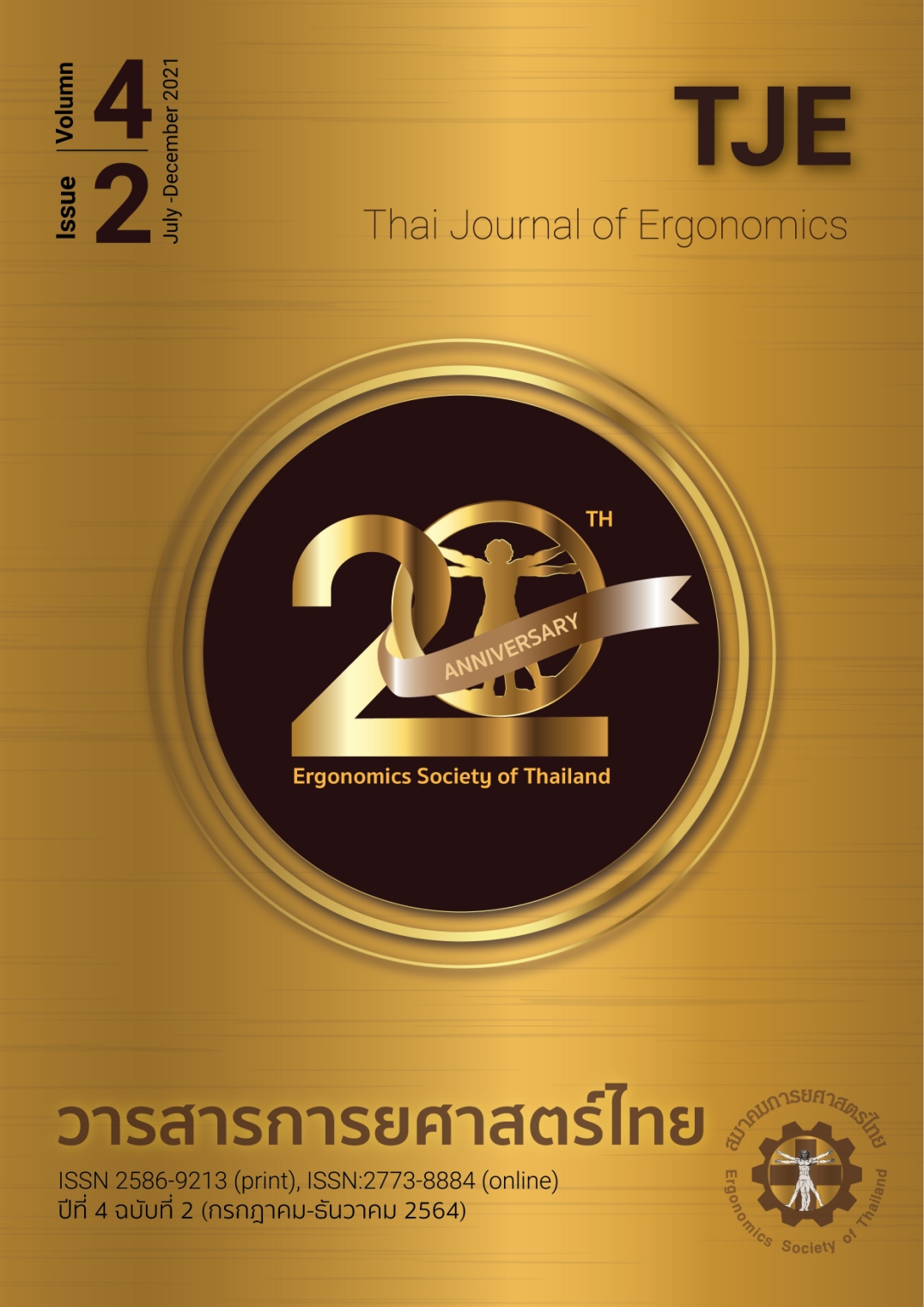การทบทวนวรรณกรรมเครื่องมือประเมินทางด้านการยศาสตร์จิตภาพ
Main Article Content
บทคัดย่อ
Cognitive Ergonomics หรือ การยศาสตร์จิตภาพ เป็นโดเมนหนึ่งของศาสตร์ทางด้านการยศาสตร์ (ergonomics) และยังเป็นเรื่องใหม่ในสังคมวิชาการในประเทศไทย จากการทบทวนงานวิจัยที่ผ่านมาพบว่าในต่างประเทศได้ให้ความสนใจงานวิจัยทางด้านนี้มากขึ้น สำหรับในประเทศไทยงานวิจัยด้านนี้ยังไม่มีการศึกษาอย่างแพร่หลายและยังไม่มีการเผยแพร่บทความทางวิชาการในเรื่องนี้มากนัก ดังนั้นในบทความนี้ได้สรุปคำนิยาม ตัวอย่างงานวิจัย และวิธีในการประเมินทางด้าน cognitive ergonomics ใน 2 ประเด็นที่สำคัญได้แก่ 1) การประเมินภาระงานด้านความคิด (mental workload assessment) 2) การตระหนักในสถานการณ์ (situation awareness) ในแต่ละประเด็นจะอธิบายวิธีที่ใช้วัดและประเมินที่หลากหลาย ซึ่งนักวิจัยและผู้ที่สนใจสามารถนำไปประยุกต์ใช้ในงานวิจัยทางด้าน cognitive ergonomics ต่อไป
Article Details
References
Matt Middlesworth. Ergonomics 101: The definition, domains, and applications of ergonomics. 2021 [cited 2021 Jan 20]. Available from: https://ergo-plus.com/ergonomics-definition-domains-applications/
สถาบันส่งเสริมความปลอดภัย อาชีวอนามัย และสภาพแวดล้อมในการทำงาน (องค์การมหาชน). คู่มือการปรับปรุงการปฏิบัติงานยกและเคลื่อนย้ายวัสดุด้วยแรงกายตามหลักการยศาสตร์. พิมพ์ครั้งที่ 1. กรุงเทพฯ: บริษัท ชยากร พริ้นติ้ง จำกัด; 2562.
Reinerman-Jones L, Matthews G, Mercado JE. Detection tasks in nuclear power plant operation: vigilance decrement and physiological workload monitoring. Saf Sci. 2016;88:97-107.
Fernandes A, Braarud, PØ. Exploring measures of workload, situation awareness, and task performance in the main control room. Procedia Manuf. 2015;3:1281-8.
Stapel J, Mullakkal-Babu FA, Happee R. Automated driving reduces perceived workload, but monitoring causes higher cognitive load than manual driving. Transp Res F: Traffic Psychol Behav. 2019;60:590-605.
Young MS, Brookhuis KA, Wickens CD. Hancock PA. State of science: mental workload in ergonomics. Ergonomics 2015;58:1-17.
Paxion J, Galy E, Berthelon C. Mental workload and driving. Front Psychol. 2014;5:1344.
De Winter JC, Happee R, Martens MH, Stanton NA. Effects of adaptive cruise control and highly automated driving on workload and situation awareness: a review of the empirical evidence. Transp Res F: Traffic Psychol Behav. 2014;27:196-217.
Butmee T, Lansdown TC, Walker GH. Mental workload and performance measurements in driving task: a review literature. In: Bagnara S, Tartaglia R, Albolino S, Alexander T, Fujita Y. Editors. IEA 2018. Proceedings of the 20th Congress of the International Ergonomics Association; 2018 Aug 26-30; Florence: Italy. Cham: Springer Nature; 2018. p. 286-94.
Hart SG, Staveland LE. Development of NASA-TLX (Task Load Index): results of empirical and theoretical research. In: Hancock P, Meshkati N, editors, Human mental workload. North Holland: Amsterdam; 1988. p. 139-183.
Reid GB, Nygren TE. The subjective workload assessment technique: A scaling procedure for measuring mental workload. In: Hancock P, Meshkati N, editors, Human mental workload. North Holland: Amsterdam; 1988. p. 185-218.
Zijlstra FRH. Efficiency in work behaviour: A design approach for modern tools [Internet]. 1993 [cited 2021 Jan 20]. Available from: https://www.elibrary.ru/item.asp?id=6863266
Wierwille W, J Casali. A validated rating scale for global mental workload measurement applications. In: Pope AT, Haugh LD, editors. Proceedings of the Human Factors Society 27th Annual Meeting; 1983 Oct 10-14 Norfolk: USA. Santa Monica: Human Factors Society; 1983 p. 129–33.
Donmez B, Cummings ML, Graham HD, Brzezinski AS. Modified cooper harper scales for assessing unmanned vehicle displays. In: Messina E, Madhavan R, editors. Proceedings of the 10th Performance Metrics for Intelligent Systems Workshop; 2010 Sep 28-30 Baltimore: USA. New York: Association for Computing Machinery; 2010 p. 235-42.
Cantin V, Lavallière M, Simoneaub M, Teasdale N. Mental workload when driving in a simulator: Effects of age and driving complexity. Accid Anal Prev. 2009;41:763–71.
Longo L. A defeasible reasoning framework for human mental workload representation and assessment. Behav Inf Technol. 2015;34:758-86.
de Waard D. The measurement of drivers' mental workload. Netherlands: Groningen University, Traffic Research Center; 1996.
O’Donnell RD, Eggemeier FT. Workload assessment methodology. In: Boff KR, Kaufman L, Thomas JP editors. Handbook of perceptionand human performance. Volume 2. Cognitive processes and performance. New York: Wiley-Interscience; 1986. p. 42-9.
Endsley MR. Design and evaluation for situation awareness enhancement. Proc Hum Factors Ergon Soc Annu Meet. 1988;97-101.
Salmon PM, Stanton NA, Walker GH, Jenkins D, Ladva D, Rafferty L et al. Measuring situation awareness in complex systems: comparison of measures study. Int J Ind Ergon. 2009;39:490-500.
Endsley MR. Measurement of situation awareness in dynamic systems. Hum Factors. 1995;37: 65–84.
Durso FT, Hackworth CA, Truitt T, Crutchfield J, Manning C.A. Situation awareness as a predictor of performance in en route air traffic controllers. Air Traffic Control Q. 1998; 6:1–20.
Taylor RM. Situational Awareness Rating Technique (SART): the development of a tool for aircrew systems design. In: Situation awareness in Aerospace operations (AGARD-CP-478). Neuilly Sur Seine: NATO-AGARD; 1990 p. 3/1 –3/17.
Matthews MD, Beal SA. Assessing situation awareness in field training exercises. U.S. Army Research Institute for the Behavioural and Social Sciences; 2002.
Smolensky MW. Toward the physiological measurement of situation awareness: the case for eye movement measurements. In: Proceedings of the Human Factors and Ergonomics Society 37th Annual Meeting. 1993 Oct 11-15 Seattle: USA. Santa Monica: Human Factors and Ergonomics Society; 1993 p. 41.

